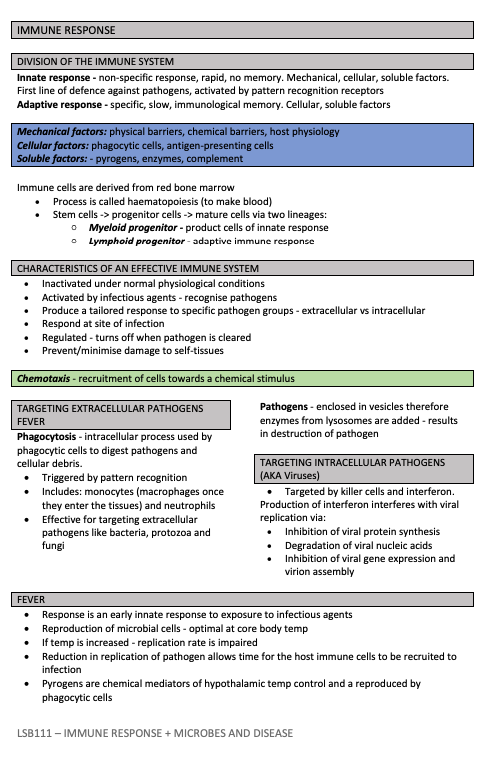LSB111 Understanding Disease Concepts
Summary:
The immune system is broadly categorized into innate and adaptive responses. The innate response offers rapid, non-specific defence using mechanisms like mechanical barriers and phagocytosis, while the adaptive response provides a slower, targeted defence with memory, primarily through B and T lymphocytes. Immune cells originate from the red bone marrow, with the differentiation process termed haematopoiesis. Effective immunity involves recognizing and efficiently responding to pathogens, then self-regulating post-threat. Pathogens can be extracellular, tackled by processes like phagocytosis, or intracellular, like viruses, countered by killer cells and interferon. Fever is a crucial innate response, impairing microbial growth by increasing body temperature. Inflammation involves a series of steps, from barrier disruption to activating adaptive immunity, and the complement system amplifies the immune response. Adaptive immunity differentiates self from non-self and operates through B-lymphocytes targeting extracellular pathogens and T-lymphocytes focusing on intracellular threats. Immunity can be actively acquired, as when fighting off an infection, or passively, as in maternal antibody transfer. Lymphocytes mature in primary lymphoid organs like the bone marrow and thymus and function in secondary organs like lymph nodes. However, the immune system can face challenges like immunodeficiencies, hypersensitivities, and autoimmune diseases where it mistakenly targets one’s cells. The interaction between the host and microbes varies from mutualistic to parasitic relationships. Endogenous microbiota plays vital roles in digestion, immunity, and overall health, while prokaryotic infectious agents, like bacteria, remain distinct from human cells and lack membrane-bound organelles.
Excerpt:
LSB111 Understanding Disease Concepts
IMMUNE RESPONSE
DIVISION OF THE IMMUNE SYSTEM
Innate response – non-specific response, rapid, no memory. Mechanical, cellular, and soluble factors. Pattern recognition receptors activate the first line of defence against pathogens.
Adaptive response – specific, slow, immunological memory. Cellular, soluble factors.
Mechanical factors: physical barriers, chemical barriers, host physiology.
Cellular factors: phagocytic cells, antigen-presenting cells.
Soluble factors: – pyrogens, enzymes, complement.
Immune cells are derived from red bone marrow
- The process is called haematopoiesis (to make blood)
- Stem cells -> progenitor cells -> mature cells via two lineages:
- Myeloid progenitor – product cells of the innate response.
- Lymphoid progenitor – adaptive immune response.


Reviews